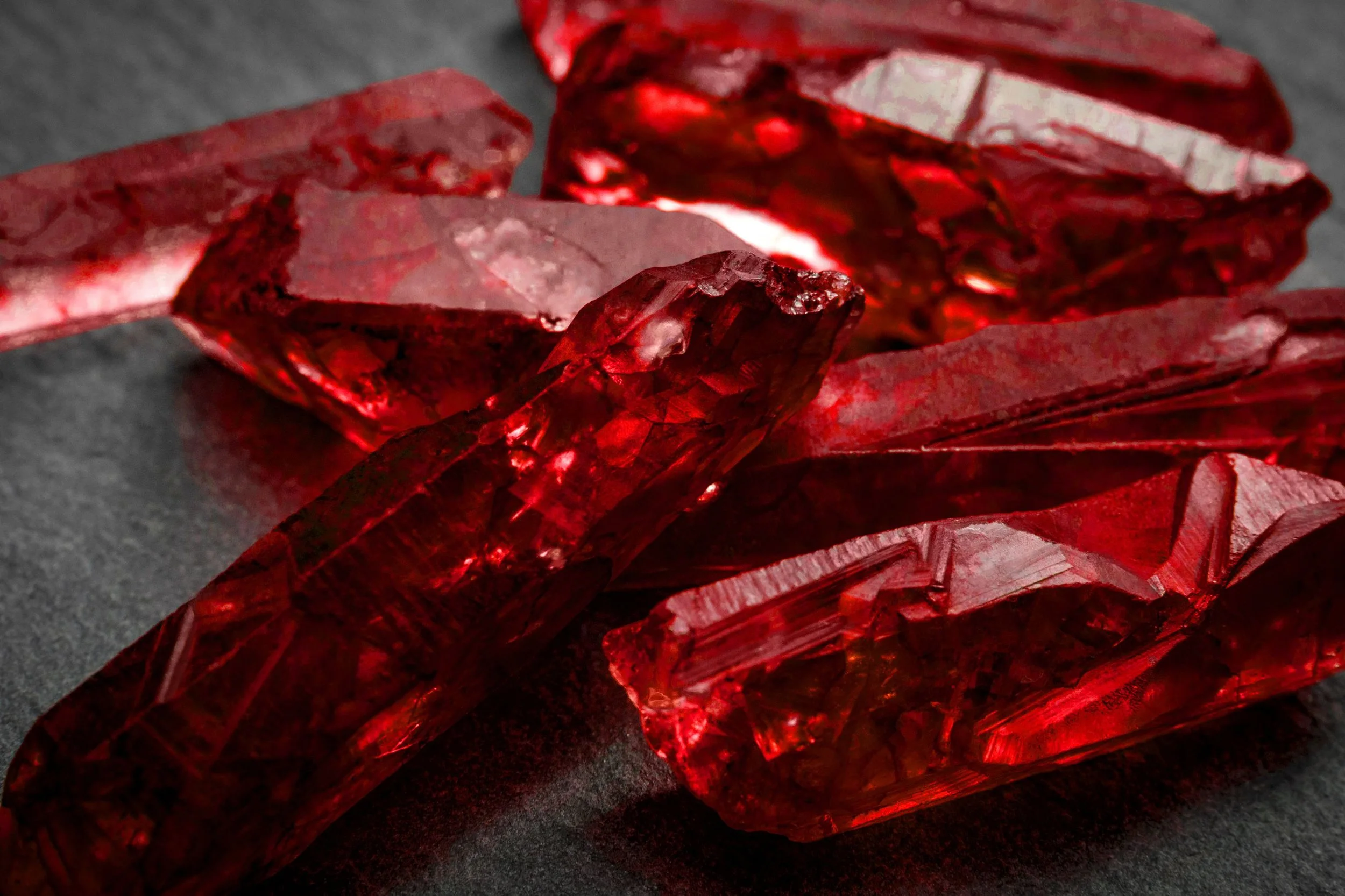Ruby
Meanings: lovers’ passion, victory in battle, energy, power, and good health and fortune are all meanings attributed to the ruby over its long history.
Name Origin: From the Latin ruber, which means red.
History: The color of rubies varies mostly based on the amount of chromium present in the mineral-based crystal formation of corundum. The balance of these minerals within the ruby rock determines the hue of the ruby and its color on the spectrum. Rubies range from bright red to a deep red enriched with purple hues, (called ‘pigeon’s blood’). In fact, cultures have often associated the ruby with blood – either representing victory in battle, (like the Burmese warriors), or with a life-blood force – imbuing power and youthful energy in those who revere it. It was often encrusted upon the sword hilts of warriors to represent strength and victory, and one culture is said to have cut into flesh of their warriors to place a ruby in their skin to ensure protection and procure victory in battle.
The stone was very important to the inhabitants of India and the surrounding regions, and it was reverently considered to be the “King of Gemstones,” bequeathing strength, vigor, and vitality to those who possessed it. In the early days of the Hindu religion, believers often offered rubies to their gods to gain favor and be granted reincarnation as powerful kings or emperors in their next life. But it also had simple uses, and often men and women of India would rub the stone on their skin to calm inflammatory illnesses. Because of its brilliant red color, some ancient cultures associated the gemstone with flames, and heat. Reportedly the ancient Greeks believed that if you tossed a ruby into a pot of water, it would come to a boil instantaneously.
Unsurprisingly, the ruby is associated with love, romance, and heated passion, and the amount of times a writer or poet (ancient and modern!) has written a line about ‘ruby lips’ is, well, predictable. (Pretty sure my early poetry makes me guilty as charged!) Also unsurprisingly, (as you know from the June Birthflower post), the rose (and especially the red rose), are symbols of passion and romance, so the amount of poets who thought they were being clever by using the adjective ‘ruby’ to describe the color of a rose is… also predictable. (Again, guilty as charged. One of my first poems in high school was entitled, “The Ruby Rose.”) But it just goes to show that the association of rubies and romance is far from imagined.
Sources: One of the first areas the ruby was mined is modern-day Myanmar, (formerly Burma). Its discovery in that region goes back at least five centuries. The late 19th century revealed significant ruby mines in Vietnam in both the Luc Yen region and the Quy Chau district, and both areas are chief suppliers to modern-day distributors. Mozambique recently unearthed rubies so rich in tone, hue, and beauty that have been compared to the famed Mogok rubies of ancient India. Thailand and Cambodia have also yielded plentiful sources of rubies in today’s market. Other sources in the middle-east also yield a steady supply of the gorgeous red stone. The rarest and most stunning rubies have mainly been found in Myanmar and Thailand.
Fun Facts:
· The durability of the ruby on the Moh’s hardness scale is second only to the diamond!
· The ancient Indians believed the ruby could quell anger.
· The ancient Chinese would bury rubies beneath the foundations of buildings, believing that the ruby would bestow good luck and fortune upon the inhabitants. (Ooh, maybe I need to try that trick! What if I build a garden shed and bury my grandmother’s old ruby ring beneath it? Would that make my garden thrive? Aaah, my imagination runs away with me…)
· Ruby is the gemstone for the 15th and 40th wedding anniversaries
· Those who wear the ruby are said to be protected from heartbreak and enjoy a boost of faithfulness and love from their partner.
· One of the most famous rubies in the world is called “The Sunrise Ruby” sold at auction in 2015 for thirty-million dollars. It is named after a poem written by the famous 13th century poet, Rumi, (unsurprisingly entitled The Sunrise Ruby.)
The ruby as featured in select Poetry:
Rubies
By Ralph Waldo Emerson
They brought me rubies from the mine,
And held them to the sun;
I said, they are drops of frozen wine
From Eden's vats that run.
I looked again,—I thought them hearts
Of friends to friends unknown;
Tides that should warm each neighboring life
Are locked in sparkling stone.
But fire to thaw that ruddy snow,
To break enchanted ice,
And give love's scarlet tides to flow,—
When shall that sun arise?









